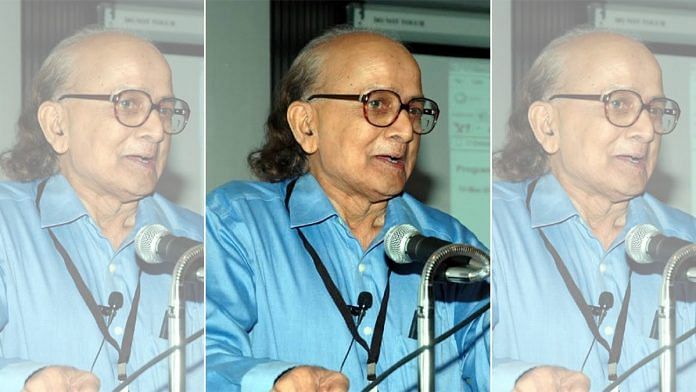Bengaluru: Astrophysicist Shashikumar Madhusudhan Chitre, who is known for his extensive work on solar physics and research into gravitational lensing, died in Mumbai Monday after a brief illness. He was 84.
The scientist had been admitted to a private hospital in Mumbai. He is survived by his wife, sons, and grandchildren.
Chitre was a former senior professor at the Tata Institute of Fundamental Research (TIFR) in Mumbai from where he retired in 2001. He was also the former president of the Astronomical Society of India and an honorary executive director at the Homi Bhabha Fellowship Council.
He was honoured with India’s third highest civilian award, Padma Bhushan, for his contribution to the sciences by the Government of India in 2012.
The news of his death was met with outpourings of grief from the scientific community.
Prof Chitre was a beloved mentor, his lectures on "Problems in Astronomy & Astrophysics", and "The Sun" at the Nehru Planetarium in 1986 stoked my love for science. Years later his enthusiasm in getting the CEBS set up was just amazing, and with his wit, he was forever young! https://t.co/xYjfJ4MKWS
— Arnab Bhattacharya (@tifrarnab) January 12, 2021
‘Kumar’ Chitre was a scholar, scientist, and a thoughtful colleague. There was, and still is, collegiality, and only a modest level of hierarchy @TIFRScience And, much interaction over tea, across disciplines. Kumar nucleated these with his understated wit and insights. https://t.co/ypoOKOf5uE pic.twitter.com/BzR7jNxl2z
— Principal Scientific Adviser, Govt. of India (@PrinSciAdvGoI) January 11, 2021
Saddened to hear of the demise of Professor Shashikumar Chitre. He will be remembered for his work in astrophysics and subjects like solar physics, gravitational lensing and science education. His valuable work will continue inspiring students in the times to come. Om Shanti.
— Narendra Modi (@narendramodi) January 11, 2021
Early life and influences
Born on 7 May 1936, Chitre grew up in Mumbai. He received his primary education in Bandra, after which he enrolled in the Parle Tilak Vidyalaya and later King George English School for secondary education. He subsequently joined Elphinstone College/Royal Institute of Science for a Bachelor of Arts in Mathematics.
During his college days, he was inspired by his teacher, mathematician P.R. Masani, who ran a mathematics study circle at Elphinstone.
Chitre then obtained a scholarship to Cambridge’s Peterhouse in the United Kingdom for an undergraduate course called the mathematical tripos, with a focus on sunspots. It was here that he found his passion in solar physics.
After his second undergraduate degree, he moved to Churchill College for a doctorate, which he obtained from the Department of Applied Mathematics and Theoretical Physics in 1963. He shared an office with Stephen Hawking when both were at Cambridge working on their respective theses. Hawking taught Chitre to play croquet.
At Cambridge, he was also a classmate of mathematician Roger Penrose, who won the 2020 Nobel Prize in Physics for his work in black hole formation.
Chitre then joined the University of Leeds as a lecturer, where he worked very closely with English astronomer Thomas G. Cowling. He and Cowling studied magnet-hydrodynamics and solar physics.
While Chitre was keen to work with legendary astrophysicist S. Chandrasekhar at Chicago, due to lack of funds from the latter’s end, he ended up joining the California Institute of Technology (Caltech) and worked with nuclear physicist William A. Fowler and theoretical physicist Kip Thorne, who introduced him to the study of neutron stars.
In 1967, he returned to India to pursue work at TIFR, where he stayed until 2001.
Also read: Vikram Sarabhai, the father of Indian space programme who was also a connoisseur of arts
Work and legacy
Chitre’s research focussed on the Sun. He had done extensive work on understanding the solar magnetic activity cycle, the solar dynamo theory, the role of neutral particles and ions in the solar atmosphere, the coloration of sun spots, and more.
He was a key contributor to the establishment of the University of Mumbai, Department of Atomic Energy Centre for Excellence in Basic Sciences in Kalina.
Chitre was also a vocal proponent of active science communication, engaging in numerous scicomm events and activities through his life. He was the voice behind the first science show in the Nehru Planetarium in Mumbai’s Worli. He delivered numerous lectures and participated in science and mathematical meets, popularising astronomy to non-scientists.
He is also credited with having an influence on India’s science policies in the recent decades.
Prof. S. M. Chitre (May 1936 – Jan 2021), a Padma Bhushan recipient and former president of Astron. Soc. of India passed away today after a brief illness. He was a great solar physicist who was also instrumental in shaping India's science policy in recent decades. pic.twitter.com/1OIUw6YwFM
— Astronomy outreach (@asipoec) January 11, 2021
Chitre held many fellowships of respectable scientific institutions, such as those of all three Indian science academies (Indian Academy of Sciences, Indian National Science Academy, National Academy of Sciences), the Royal Astronomical Society, the International Astronomical Union, the World Academy of Sciences, as well as the Max Planck Institute for Extraterrestrial Physics.
He was also a member of the Executive Committee of the Nehru Science Centre, Mumbai.
Also read: Mars, Moon & a fresh pair of eyes in the sky — the big space missions planned for 2021



